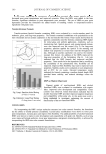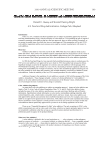18-MEA AND HAIR APPEARANCE 159 distribution curves for untreated hair and 18-MEA-removed hair. It was apparent that the removal of 18-MEA decreases the contrast between specular refl ection and other re- gions, which is due to the disorderly alignment of the hair fi bers. Broadening of specular refl ection, a luminance intensity of 88 and 18 pixels of half bandwidth, and approxi- mately a 20% decrease in luminance intensity were evident in the case of 18-MEA- removed hair, while the specular refl ection of the untreated hair was relatively sharp, having a luminance intensity of 115 and ten pixels of half bandwidth. The results revealed that the removal of 18-MEA decreases hair gloss. CONCLUSIONS The decrease in 18-MEA on the cuticle surface affects the hydrophobic–hydrophilic prop- erties of hair by providing lower advancing and receding contact angles. An important cosmetic role of 18-MEA is to allow hair fi bers to lie fl at and parallel with respect to each other in wet environments by providing relatively high receding contact angles and low surface friction. Hair alignment in the dry environment, which infl uences hair luster, is directly affected by hair alignment in the wet environment, particularly in the case of damaged hair. REFERENCES (1) C. R. Robbins, Chemical and Physical Behavior of Human Hair, 4th ed. (Springer-Verlag, New York, 2002). (2) A. P. Negri, H. J. Cornell, and D. E. Rivett, The nature of covalently bound fatty acids in wool fi bers, Aust. J. Agric. Res., 42, 1285–1292 (1991). (3) A. P. Negri, H. J. Cornell, and D. E. Rivett, Effects of proceeding on the bound and free fatty acid levels in wool, Text. Res. J., 62, 381–387 (1992). (4) S. Naito, M. Ooshika, N. Yorimoto, and Y. Kuroda, The structure of bound lipids of human hair fi bers and its physical properties, Proc. 9th Int. Wool Text. Res. Conf., Biella, Italy, II, 367–374 (1996). (5) D. J. Evans and M. Lanczki, Cleaavage of integral surface lipids of wool by aminolysis, Textile Res. J., 67, 435–444 (1997). (6) S. Breakspear, J. R. Smith, and G. Luengo, Effect of the covalently linked fatty acid 18-MEA on the nanotribology of hair’s outermost surface, J. Struct. Biol., 149, 235–242 (2005). (7) V. Dupres, T. Camesano, D. Langevin, A. Checco, and P. Guenoun, Atomic force microscopy imaging of hair: Correlations between surface potential and wetting at the nanometer scale, J. Colloid Interface Sci., 269, 329–335 (2004). (8) V. Dupres, D. Langevin, P. Guenoun, A. Checco, G. Luengo, and F. Leroy, Wetting and electrical prop- erties of the human hair surface: Delipidation observed at the nanoscale, J. Colloid Interface Sci., 306, 34–40 (2007). (9) U. Kalkbrenner, H. Koener, H. Hoecker, and D. E. Rivett, Studies on the composition of the wool cu- ticle, Proc. 8th Int. Wool Text. Res. Conf., Christchurch, New Zealand, I, 398–407 (1990). (10) M. Huson, D. Evans, J. Church, S. Hutchinson, J. Maxwell, and G. Corino, New insights into the na- ture of the wool fi bre surface, J. Struct. Biol., 163, 127–136 (2008). (11) Y. K. Kamath, C. J. Dansizer, and H.-D. Weigmann, Wettability of keratin fi ber surfaces, J. Soc. Cosmet. Chem., 28, 273–284 (1977). (12) T. Baba, N. Nagasawa, H. Ito, O. Yaida, and T. Miyamoto, Changes in the covalently bound surface lipid layer of damaged wool fi bers and their effects on surface properties, Textile Res. J., 71, 308–312 (2001). (13) R. Molina, F. Comelles, M. R. Julia, and P. Erra, Chemical modifi cations on human hair studies by means of contact angle determination, J. Colloid Interface Sci., 237, 41–46 (2001). (14) R. A. Lodge and B. Bhushan, Wetting properties of human hair by means of dynamic contact angle measurement, J. Appl. Polym. Sci., 102, 5255–5265 (2006).
JOURNAL OF COSMETIC SCIENCE 160 (15) R. E. Johnson, Jr. and R. H. Dettre, Contact angle hysteresis. III. Study of an idealized heterogeneous surface, J. Phys. Chem., 68, 1744–1750 (1964). (16) Y. L. Chen, C. A. Helm, and J. N. Israeachvili, Molecular mechanisms associated with adhesion and contact angle hysteresis of monolayer surfaces, J. Phys. Chem., 95, 10736–10747 (1991). (17) J. C. Berg, Wettability, Surfactant Science Series 49 (Marcel Dekker, New York, 1993). (18) A. Marmur, Contact angle hysteresis on heterogeneous smooth surfaces, J. Colloid Interface Sci., 168, 40–46 (1994). (19) O. N. Tretinnikov and Y. Ikeda, Dynamic wetting and contact angle hysteresis of polymer surfaces studies with the modifi ed Wilhelmy balance method, Langmuir, 10, 1606–1614 (1994). (20) Y. K. Kamath, C. J. Dansizer, and H.-D. Weigmann, Wetting behavior of human hair fi bers, J. Appl. Polym. Sci., 22, 2295–2306 (1978). (21) B. Bhushan, Nanoscale characterization of human hair and hair conditioners, Prog. Mat. Sci., 53, 585– 710 (2008).
Purchased for the exclusive use of nofirst nolast (unknown) From: SCC Media Library & Resource Center (library.scconline.org)





































































































































